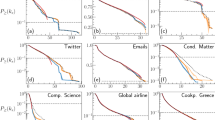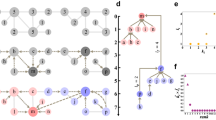Abstract
Communities are a powerful tool to describe the structure of complex networks. Algorithms aiming at maximizing a quality function called modularity have been shown to effectively compute the community structure. However, some problems remain: in particular, it is possible to find high modularity partitions in graph without any community structure, in particular random graphs. In this paper, we study the notion of consensual communities, or community cores, and show that they do not exist in random graphs. For that, we exhibit a phase transition based on the strength of consensus: below a given threshold, all the nodes belongs to the same consensual community; above this threshold, each node is in its own consensual community. We compare the results using different quality functions as well as different models of random graphs, with or without communities.
The work presented in this paper is an extension of [6].
Access this chapter
Tax calculation will be finalised at checkout
Purchases are for personal use only
Similar content being viewed by others
Notes
- 1.
Also, an execution takes less than one hour on a network with more than one billion of nodes and links.
- 2.
Assumptions in classical mean field make extensive use of the fact that a random graph whose size tends to infinity is locally a tree.
References
Ah-Pine J, Marcotorchino JF (2007) Statistical, geometrical and logical independences between categorical variables symposium. In: Proceedings of the international conference on applied stochastic models and data analysis (ASMDA). Chania, Greece
Bender EA, Canfield ER (1978) The asymptotic number of labeled graphs with given degree sequences. J Comb Theory A 24:296–307
Blondel V, Guillaume JL, Lambiotte R, Lefebvre E (2008) Fast unfolding of communities in large networks. J Stat Mech: Theory Exp 2008:P10008
Brandes U, Delling D, Gaertler M, Gorke R, Hoefer M, Nikoloski Z, Wagner D (2007) On finding graph clusterings with maximum modularity. In: Graph-theoretic concepts in computer science. Springer, Berlin, pp 121–132
Campigotto R, Conde-Céspedes P, Guillaume JL (2014) A generalized and adaptive method for community detection. Technical report, Université Pierre et Marie Curie. arXiv:14062518
Campigotto R, Guillaume JL, Seifi M (2013) The power of consensus: random graphs have no communities. In: Proceedings of the 5th IEEE/ACM international conference on advances in social networks and mining (ASONAM). Niagara Falls, Canada, pp 272–276
Conde-Céspedes P, Marcotorchino JF (2013) Comparison of linear modularization criteria of networks using relational metric. In: 45èmes Journées de Statistique, SFdS. Toulouse, France
Diday E (1973) The dynamic clusters method and optimization in non-hierarchical clustering. Optim Tech, pp 241–258
Diday E (1973) The dynamic clusters method in non-hierarchical clustering. Int J Parallel Prog 2:61–88
Erdős P, Rényi A (1959) On random graphs. Publ Math 6:290–297
Fortunato S (2010) Community detection in graphs. Phys Rep 486(3–5):75–174
Gfeller D, Chappelier J, De Los Rios P (2005) Finding instabilities in the community structure of complex networks. Phys Rev E 72(5):056135
Girvan M, Newman MEJ (2002) Community structure in social and biological networks. Proc Natl Acad Sci USA 99(12):7821–7826
Guimerà R, Danon L, Diaz-Guilera A, Giralt F, Arenas A (2003) Self-similar community structure in a network of human interactions. Phys Rev E 68(6):065103
Guimerà R, Sales-Pardo M, Amaral LAN (2004) Modularity from fluctations in random graphs and complex networks. Phys Rev E 70(2):025101
Janson S, Vegelius J (1982) The J-index as a measure of association for nominal scale response agreement. Appl Psychol Meas 6:111–121
Karrer B, Levina E, Newman M (2008) Robustness of community structure in networks. Phys Rev E 77(4):046119
Lancichinetti A, Fortunato S, Radicchi F (2008) Benchmark graphs for testing community detection algorithms. Phys Rev E 78(4):046110
Lancichinetti A, Fortunato S (2012) Consensus clustering in complex networks. Sci Rep 2(336)
Mancoridis S, Mitchell B, Rorres C (1998) Using automatic clustering to produce high-level system organizations of source code. In: Proceedings of the 6th international workshop on program comprehension, pp 45–53
Marcotorchino JF (2013) Optimal transport, spatial interaction models and related problems, impacts on relational metrics, adaptation to large graphs and networks modularity
Molloy M, Reed B (1995) A critical point for random graphs with a given degree sequence. Random Struct Algorithms 6(2–3):161–180
de Montgolfier F, Soto M, Viennot L (2011) Asymptotic modularity of some graph classes. In: ISAAC, pp 435–444
Newman M (2001) The structure of scientific collaboration networks. Proc Natl Acad Sci 98(2):404–409
Newman M, Girvan M (2004) Finding and evaluating community structure in networks. Phys Rev E 69(2):026113
Reichardt J, Bornholdt S (2006) Statistical mechanics of community detection. Phys Rev E 74(1):016110
Rosvall M, Bergstrom C (2010) Mapping change in large networks. PLoS One 5(1):e8694
Seifi M, Guillaume JL (2012) Community cores in evolving networks. In: Proceedings of the mining social network dynamic 2012 workshop (MSND). Lyon, France, pp 1173–1180
Seifi M, Guillaume JL, Junier I, Rouquier JB, Iskrov S (2012) Stable community cores in complex networks. In: 3rd international workshop on complex networks. Melbourne, Florida
Senshadhri C, Kolda TG, Pinar A (2012) Community structure and scale-free collections of Erdős-Rényi graphs. Phys Rev E 85:056109
Shi J, Malik J (2000) Normalized cuts and image segmentation. IEEE Trans Pattern Anal Mach Intell 22:888–905
Wang Q, Fleury E (2010) Uncovering overlapping community structure. In: 2nd international workshop on complex networks, pp 176–186
Wang Q, Fleury E (2009) Detecting overlapping communities in graphs. In: European conference on complex systems (ECCS). Warwick
Zachary WW (1977) An information flow model for conflict and fission in small groups. J Anthr Res 33:452–473
Zahn CT (1964) Approximating symmetric relations by equivalence relations. SIAM J Appl Math 12:840–847
Acknowledgments
We would like to thank the anonymous referees for their insightful comments and suggestions, which have helped to improve the presentation of this paper. This work is partially supported by the DynGraph ANR-10-JCJC-0202 and CODDDE ANR-13-CORD-0017-01 projects of the French National Research Agency.
Author information
Authors and Affiliations
Corresponding author
Editor information
Editors and Affiliations
Rights and permissions
Copyright information
© 2014 Springer International Publishing Switzerland
About this chapter
Cite this chapter
Campigotto, R., Guillaume, JL. (2014). The Power of Consensus: Random Graphs Still Have No Communities. In: Missaoui, R., Sarr, I. (eds) Social Network Analysis - Community Detection and Evolution. Lecture Notes in Social Networks. Springer, Cham. https://doi.org/10.1007/978-3-319-12188-8_7
Download citation
DOI: https://doi.org/10.1007/978-3-319-12188-8_7
Published:
Publisher Name: Springer, Cham
Print ISBN: 978-3-319-12187-1
Online ISBN: 978-3-319-12188-8
eBook Packages: Computer ScienceComputer Science (R0)




